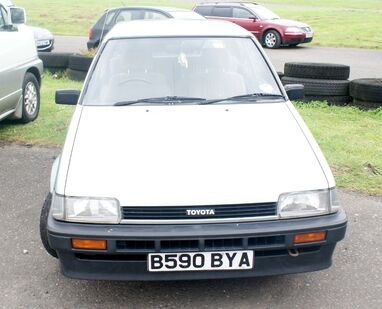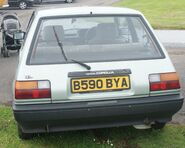
1985 Toyota Corolla
The Toyota Corolla is a line of subcompact and compact cars manufactured by the Japanese automaker Toyota, which has become very popular throughout the world since the nameplate was first introduced in 1966. In 1997, the Corolla became the best selling nameplate in the world, with over 35 million sold as of 2007, surpassing the Volkswagen Beetle. Over the past 40 years, one Corolla car has been sold on average every 40 seconds. The series has undergone several major redesigns.
The name Corolla is part of Toyota's naming tradition of using the name Crown for primary models: the Corona, for example, gets its name from the Latin for crown; Corolla is Latin for small crown; and Camry is an Anglicized pronunciation of the Japanese for crown, kanmuri.
Corollas are manufactured in Japan and in Brazil (Indaiatuba, São Paulo), Canada (Cambridge, Ontario), China (Tianjin), India (Bangalore), Indonesia, Malaysia, Pakistan, Philippines, South Africa (Durban), Taiwan, Thailand, Turkey, the United Kingdom (Derbyshire) and Venezuela. Production has previously been made in Australia (Victoria). Production in the United States (Fremont, California) ended in March 2010.
The Corolla's chassis designation code is "E", as described in Toyota's chassis and engine codes.
Early models were mostly rear-wheel drive, later models were mostly front-wheel drive and some models were four-wheel drive.
First generation (E10)[]
The Corolla E10 was the first generation of cars sold by Toyota under the Corolla nameplate.
The Corolla was launched in Japan in November 1966 at a Japanese dealership sales channel called Toyota Corolla Store . Eiji Toyoda said it worked hard to create popular demand, and disputes that Toyota rode a wave of private car ownership that was taking off in the mid-1960s. Its major competitor was the Datsun 1000, released a few months before the Corolla. Its companion, the Toyota Sprinter, was sold at a different dealership sales channel called Toyota Auto Store.
The initial car, the KE1x series was small, with a 90 in (2286 mm) wheelbase. Transmission was by a 4-speed floor shift manual transmission or a 2-speed floor or column shift automatic transmission, with rear wheel drive. At the time, floor shift transmissions were considered only for trucks and 4 speeds implied that the engine did not have enough torque to drive through only 3 gears (more torque allows each gear to have a wider spread of engine revolutions, thus requiring fewer gears). This was a big risk for Toyota but the effectiveness of the new system gained in popularity.
The suspension in front was MacPherson struts supported by a transverse leaf spring beneath the engine cross-member, with leaf springs connected to a solid axle in back.
The engine was originally meant to be for the under 1000 cc tax class but was changed late in the design process to be 1077 cc in order to beat the forthcoming Datsun 1000. This put it into a 1000cc engine road tax class but gave it some prestige over the Datsun 1000 - helped by its "100 cc advantage" advertising campaign. In August 1969 the engine was upgraded to 1166 cc. Special twin carburettor K-B (1077 cc) and 3K-B (1166 cc) engines were used in the SL grade models for an extra 13 hp (9.7 kW).
Second generation (E20)[]
The Corolla E20 was the second generation of cars sold by Toyota under the Corolla nameplate.
The second-generation KE2# / TE2# model, launched in May 1970, had "coke-bottle" styling. It had a longer 91.9 in (2334 mm) wheelbase. The front suspension design was improved greatly, using a swaybar, however the rear remained relatively similar. The Corolla became the second-best selling car in the world that year. Grades for sedan were Standard, Deluxe, and Hi-Deluxe. The coupé was offered in Deluxe, SL, SR, and Levin as well as Sprinter variants. The Sprinter Trueno was equivalent to the Corolla Levin.
Minor changes were made in September 1971 with a new grille, turn signal lights, and tail lights, along with similar treatment to the Sprinter. A further facelift was done in August 1972.
Third generation (E30, E40, E50, E60)[]
The Corolla E30 was the third generation of cars sold by Toyota under the Corolla nameplate. It was built from August 1974[1] to July 1981[1] and marked Toyota's greatest growth in the United States in the wake of the fuel crisis. In addition to its sister model, the Sprinter, there was a redesigned-body version built by Toyota affiliate Daihatsu, called the Daihatsu Charmant. While there were certain fourth-generation models with a longer model life, this generation, when considered as a whole, was the longest-lived one, possibly due to the worldwide recession in the 1970s. A large range of cars were built using this chassis, including Corollas, Sprinters, Daihatsu, and the sporty Levin and Trueno models with the DOHC motor.
The 3K engine was used in certain markets and later the 4K, while most Japanese and American models had the bigger 2T engine. A "Toyoglide" 2/3-speed automatic transmission was added as well as a four-speed and five-speed manual transmission, driving to the rear wheels. A three-door "liftback" (E50) and sports coupé (E51) was added in 1976. The E40 and E60 series were assigned to the Sprinter variants.
Even though the E30 and E50 series were replaced by the E70 series in August 1979 in most markets, the original E30 series and the facelifted E50 series both continued production until July 1981
Fourth generation (E70)[]
The Corolla E70 was the fourth generation of cars sold by Toyota under the Corolla nameplate.
The fourth-generation model released in 1979 in Japan, was boxy and was the last generation to have the entire lineup in rear-wheel-drive. Although most of the fourth generation was replaced by 1984, the station wagon and van versions were offered into 1987. In 1980 Corolla daily production reached an all-time high, averaging 2,346 units.
This generation (apart from the wagon) got a new rear coil spring five-link rear end with a panhard rod, and the wheelbase was longer at 94.5 in (2400 mm). A new underwhelming 1.8 L (1770 cc/108 in³) 3T engine was optional to some markets, while parts of the world retained the old 4K. The most notable inline-four engine advancement came in 1983, however, as Toyota began offering the 1.6 L (1587 cc/96 in³) 4A-C. The aluminum head, SOHC engine, although bulkier in size and weight than the K and T engines it was offered alongside, was a grand step up in performance. This would be the last generation of Corollas to use any pushrod or iron cylinder head engines, as Toyota made the decision to focus exclusively on aluminium head, OHC engine design from this point forward. This was the first generation to have power steering. In the US market, this was introduced in the 1981 for the 1982 model year.
Various facelifts were made during production. In 1979-1980, a 4-round headlamp setup was used in most markets. A restyle for 1981 involved two rectangular headlamps. A more extensive facelift was given for 1982, involving wraparound headlights, remodeled taillights and new bumpers, which on some models were rubber moulded.
Fifth generation (E80)[]
The Corolla E80 was the fifth generation of cars sold by Toyota under the Corolla nameplate. The fifth generation is generally regarded as the most popular Corolla when measured against its contemporaries, and some 3.3 million units were produced. This model, from 1983, moved the Corolla into front wheel drive, except for the AE85 and AE86 Corolla Levin / Sprinter Trueno models (SR-5 / GT-S in USA) which continued on the older rear wheel drive platform, along with the three-door "liftback" (E72), three-door van (E70) and five-door wagon (E70) of the previous generation, that were still being produced.
The front-wheel-drive wheelbase was now 95.6 in (2428 mm). It was the first Corolla to top the New Zealand top-10 lists, ending Ford's dominance of that market. A "short" hatchback range, called the Corolla FX in Japan and the Corolla Compact in Germany, arrived in 1984, on the front-wheel-drive platform. The three and five-door hatchbacks resembled the Corolla sedan with a truncated rear deck and trunk. Although there was a five-door liftback model of the basic Corolla, the FX-based hatchback was sold alongside it. The Corolla FX replaced the Toyota Starlet in North America.
A DOHC 16-valve engine, designated 4A-GE, was added in 1983 on the rear-drive cars. It was a 1.6 L (1587 cc) I4 and produced an impressive 124 hp (92 kW), turning the Levin/Trueno (Japan), Corolla GT coupé (Europe) and Corolla GT-S into a popular sports car. The 3 door FWD hatchback with this engine was known as the Corolla FX-16. This engine was also combined with the front-drive transaxle to power the mid-engined Toyota MR-2.
The Sprinter sports cars, in two-door coupé and three-door liftback forms, were notable for the line's first use of pop-up headlamps, which the equivalent Corolla Levin sports models did not have.









